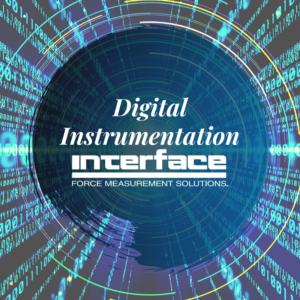Digital Instrumentation for Force Measurement
 The age of IoT (Internet of Things), where almost every vehicle, machine, and piece of equipment is connected and shares information rapidly, is also greatly impacting the world of engineering and manufacturing for the better. Data is more accessible, which allows for improved decision-making and more efficient product development cycles and design testing.
The age of IoT (Internet of Things), where almost every vehicle, machine, and piece of equipment is connected and shares information rapidly, is also greatly impacting the world of engineering and manufacturing for the better. Data is more accessible, which allows for improved decision-making and more efficient product development cycles and design testing.
The demands from customers to go digital is something that Interface has paid close attention too. Digital instruments are becoming more popular because of their advantages over analog devices, such as greater speed, increased accuracy, better resolution, reduction in operator errors and the ability to provide automatic measurements in the system application.
Interface provides a wide range of digital instruments that take load cell and strain bridge input and provides data output in a variety of protocol and bus formats, including many industry standards requirements. This combination allows our customers to transform their test and measurement programs and force measurement applications into the digital age. The results are faster data input and outputs, along with more robust analytics.
 In addition to improved efficiency, accuracy and speed, digital instrumentation and more specifically, digital signals, provides a plethora of benefits for test and measurement engineers.
In addition to improved efficiency, accuracy and speed, digital instrumentation and more specifically, digital signals, provides a plethora of benefits for test and measurement engineers.
These benefits include:
- Digital signals are less susceptible to noise
- Digital signals are more secure
- Digital signals can travel a long distance
- Digital signals allow multi-directional transmission simultaneously
- Digital instrumentation can connect to other devices and networks more easily
- Digital instrumentation can connect with protocols that they are already using in their facility
Another key reason our customers are demanding digital instrumentation is because of the push for Industry 4.0 facilities. Industry 4.0 involves the process of connecting various machines, smart and conventional, to the cloud with sensors to create a powerful sensor network.
The Industry 4.0 network will be fast and stable enough to relay data to people or other machines in real-time. This data is rapidly turned into insight and the information ultimately allows engineers and manufacturers to automate more processes to create a more efficient factory. The digital instrumentation devices that Interface provides play a significant role in helping our customers create Industry 4.0 manufacturing for OEM products and compete in the fourth industrial revolution using digital technologies.
Some of the most popular digital instrumentation devices that Interface provides include:
- INF1 Modbus TCP Weight Transmitter Indicator – The Interface Modbus/TCP indicator has a 6-digit red LED display (8 mm height), space-saving compact design, 4 buttons for the system calibration for a single channel weight transmitter.
 480 Bidirectional Weight Indicator – The 480 Bidirectional Weight Indicator comes in a NEMA 4X stainless enclosure. The standard options include 523,000 internal counts, 0.8 in. LED 6-digit display and a measurement rate that goes up to 40 Hz.
480 Bidirectional Weight Indicator – The 480 Bidirectional Weight Indicator comes in a NEMA 4X stainless enclosure. The standard options include 523,000 internal counts, 0.8 in. LED 6-digit display and a measurement rate that goes up to 40 Hz.- INF4-Ethernet TCP/IP Weight Transmitter Indicator – This 4-channel weight transmitter instrument works in an Ethernet TCP/IP network and it is accessible via a web browser. It has a 6-digit red LED semi-alphanumeric display (8 mm height) and 7 segments with a compact design, 4 buttons for the system calibration, and a 6 indicator LED.
For more information on Interface’s growing lineup up of digital instrumentation, please visit /product-category/digital-instrumentation/.









